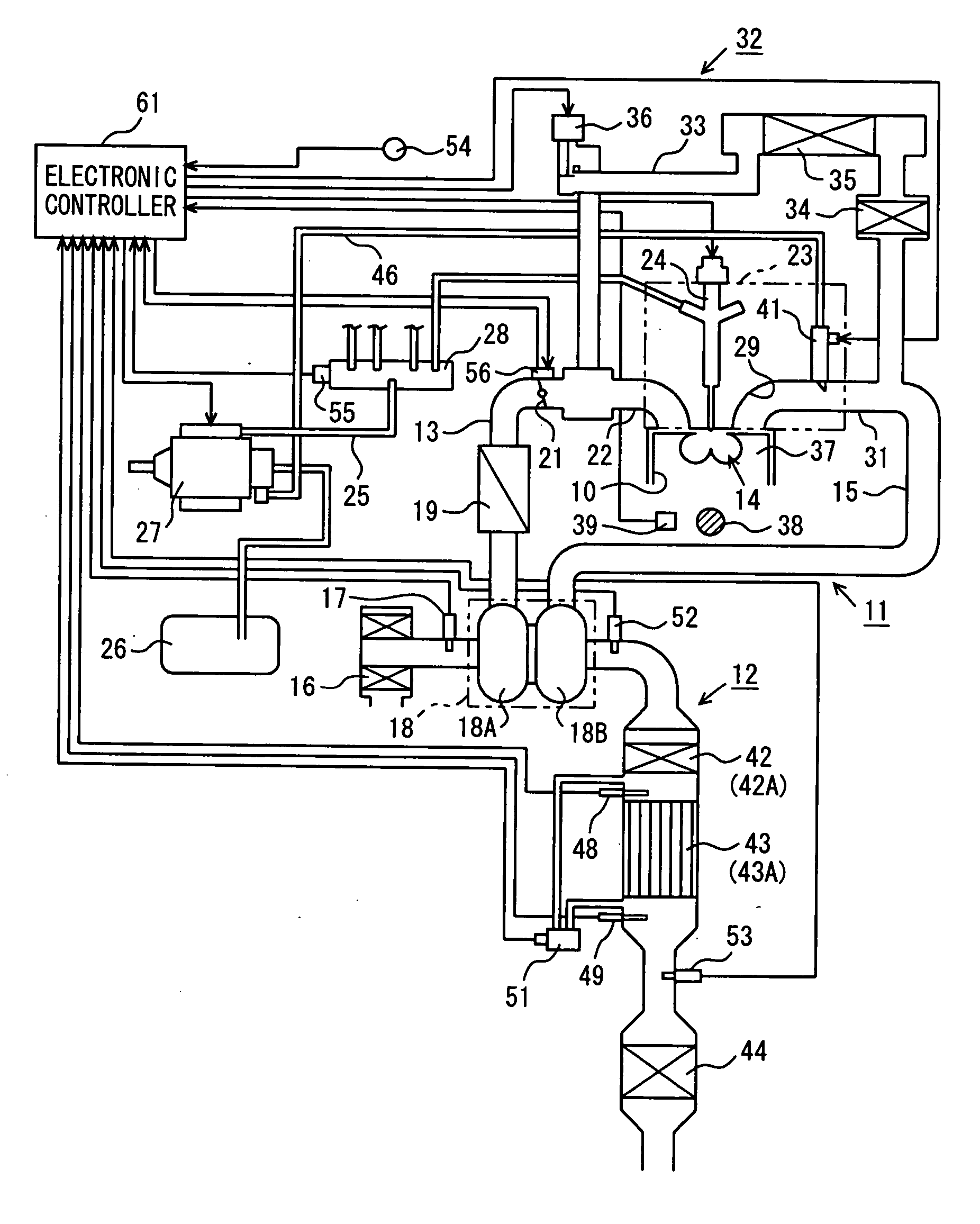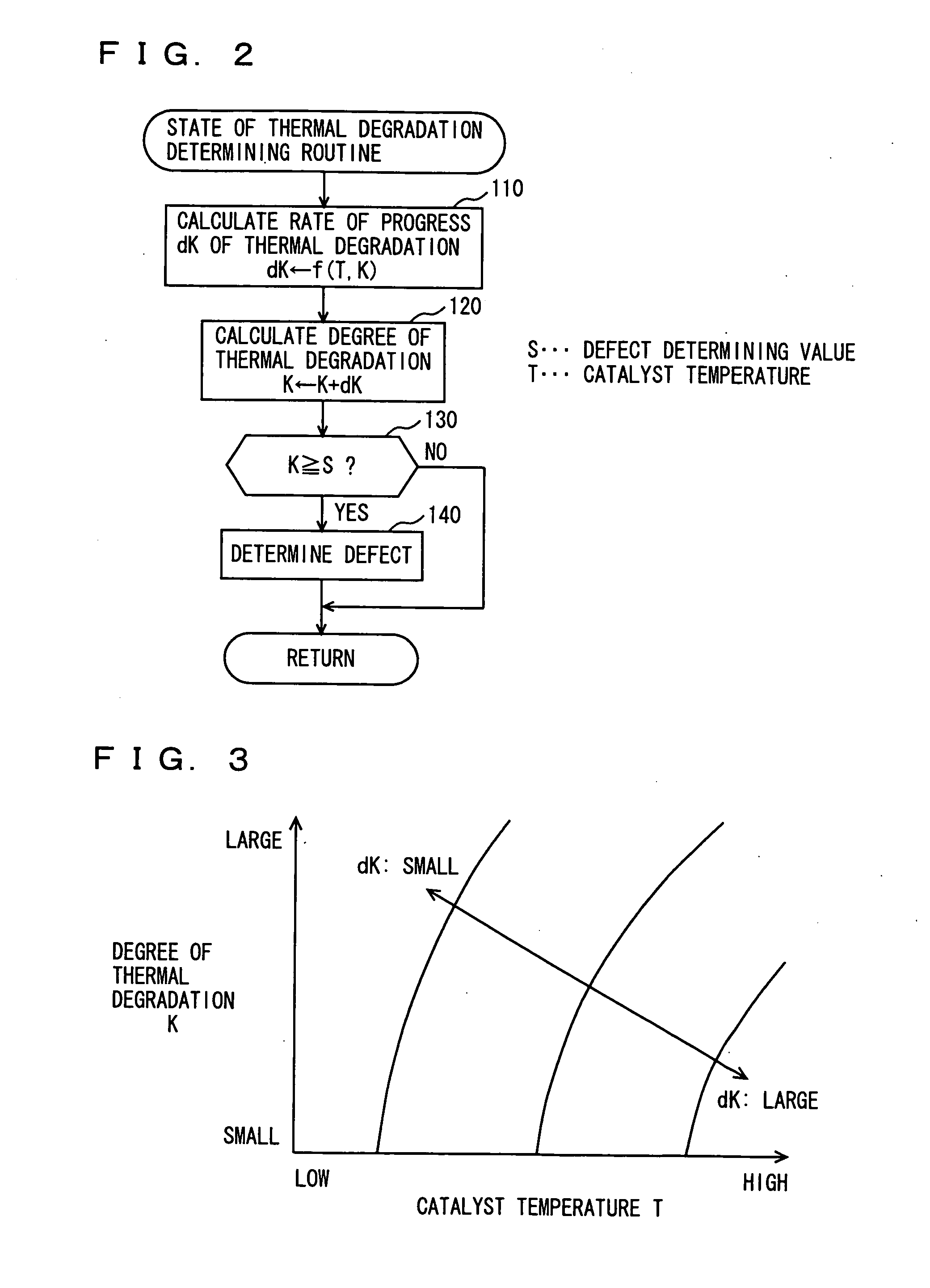[0012] An object of the present invention is to provide a device for detecting a state of thermal degradation of an exhaust purifying catalyst, which can exactly ascertain the degree of thermal degradation of exhaust purifying catalyst and can improve accuracy in detecting a state of thermal degradation of exhaust purifying catalyst.
[0016] Here, the rate of progress of thermal degradation tends to differ in accordance with the degree of thermal degradation, in addition to the temperature of exhaust purifying catalyst. In this regard, according to the present invention, when the rate of progress of thermal degradation is integrated by the degree of thermal degradation calculating unit, based on the integrated value of the rate of progress of thermal degradation up to the last time, that is, the degree of thermal degradation calculated last time, and on the temperature of exhaust purifying catalyst at that time, the rate of progress of thermal degradation in the predetermined time period is calculated. The rate of progress of thermal degradation is added to the integrated value up to the last time (degree of thermal degradation calculated last time), and the value after the addition is regarded as the degree of thermal degradation of exhaust purifying catalyst up to the present time. Therefore, as compared with integration of the rate of progress of thermal degradation calculated based solely on the temperature of exhaust purifying catalyst, the degree of thermal degradation of exhaust purifying catalyst can more accurately be ascertained. Accordingly, the accuracy of determination (detection) of the state of thermal degradation of exhaust purifying catalyst, which is made using the degree of thermal degradation, also improves.
[0018] Here, the rate of progress of thermal degradation generally has a tendency that it is small when the temperature of exhaust purifying catalyst is low and it becomes higher as the temperature increases. In this regard, according to the present invention, as the temperature of exhaust purifying catalyst increases, a larger value is calculated as the rate of progress of thermal degradation. By this calculation, the rate of progress of thermal degradation corresponding to the amount of thermal degradation that actually developed in the predetermined time period from the last to the present time can be obtained. Therefore, by adding the value to the integrated value of rate of progress of thermal degradation up to the last time, the degree of thermal degradation from the start of use of the exhaust purifying catalyst to the present can accurately be calculated.
[0020] Here, the rate of progress of thermal degradation generally has a tendency that it is large when thermal degradation is not much developed (degree of thermal degradation is small) and it becomes smaller as thermal degradation proceeds (degree of thermal degradation increases). In this regard, according to the present invention, as the integrated value of the rate of progress of thermal degradation up to the last time (degree of thermal degradation) increases, a smaller value is calculated as the rate of progress of thermal degradation. By this calculation, the rate of progress of thermal degradation corresponding to the amount of thermal degradation that actually developed in the predetermined time period from the last to the present time can be obtained. Therefore, by adding the value to the integrated value up to the last time, the degree of thermal degradation from the start of use of the exhaust purifying catalyst to the present can accurately be calculated.
[0022] According to this arrangement, when the degree of thermal degradation is calculated by the degree of thermal degradation calculation unit, the rate of progress of thermal degradation corresponding to the integrated value of the rate of progress of thermal degradation up to the last time, that is, the degree of thermal degradation up to the last time and the temperature of exhaust purifying catalyst at that time, is read from the storage unit, and this is added as the rate of progress of thermal degradation for the predetermined time period, to the integrated value up to the last time. In this manner, the relation among the rate of progress of thermal degradation and the degree of thermal degradation and the temperature of exhaust purifying catalyst is stored in advance in the storage unit, and the rate of progress of thermal degradation is read at every predetermined time period. Therefore, burden on the operating device can be alleviated as compared with the example in which the rate of progress of thermal degradation corresponding to the temperature of exhaust purifying catalyst and the degree of degradation is calculated by operation at every predetermined time period.
[0024] According to this arrangement, when the state of thermal degradation of exhaust purifying catalyst is detected, the determining unit compares the degree of thermal degradation calculated by the degree of thermal degradation calculating unit with a predetermined value. If the comparison result indicates that the degree of thermal degradation is larger than the predetermined value, it is determined that the exhaust purifying catalyst is defective because of thermal degradation. Therefore, by setting an upper
limit value or a value close to the upper
limit value of tolerable range of thermal degradation of exhaust purifying catalyst as the predetermined value, it becomes possible to ascertain whether the state of thermal degradation of the exhaust purifying catalyst is defective or not.
 Login to View More
Login to View More  Login to View More
Login to View More 


